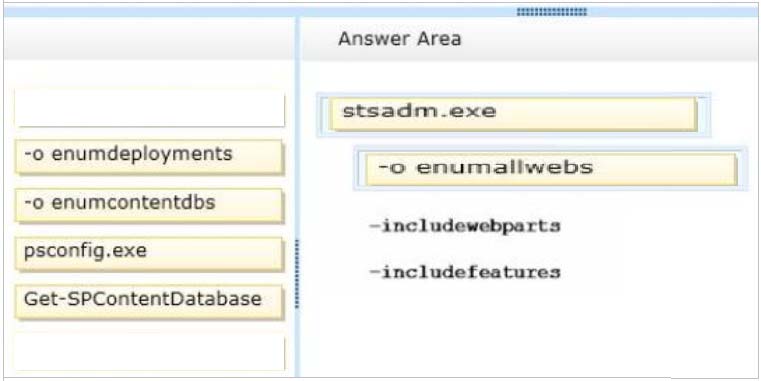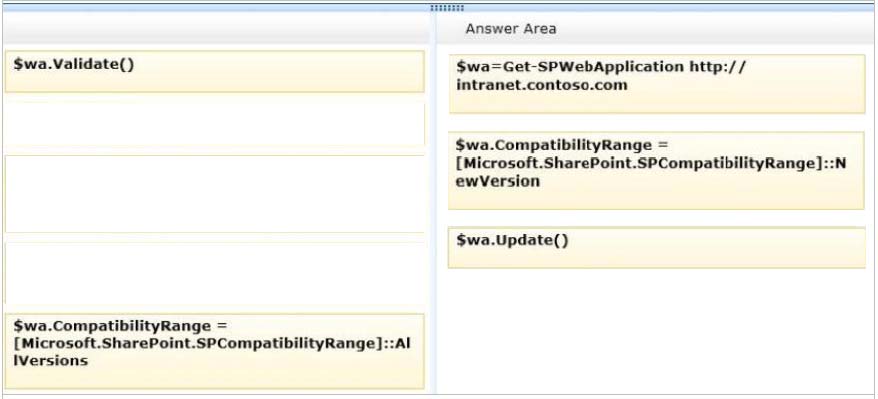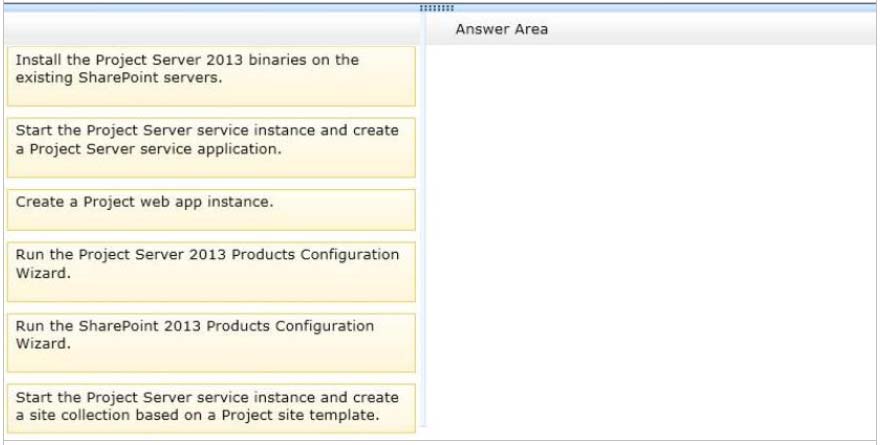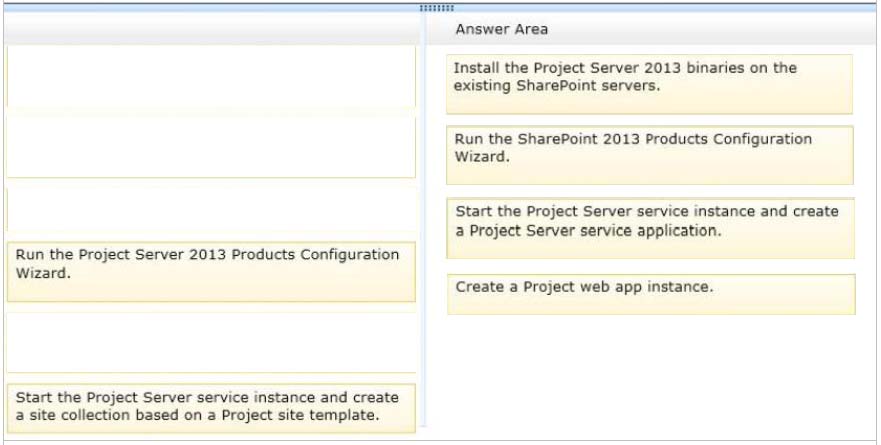Microsoft 70-332 Exam Practice Questions (P. 2)
- Full Access (127 questions)
- Six months of Premium Access
- Access to one million comments
- Seamless ChatGPT Integration
- Ability to download PDF files
- Anki Flashcard files for revision
- No Captcha & No AdSense
- Advanced Exam Configuration
Question #6
DRAG DROP -
A company plans to upgrade from a SharePoint Server 2010 farm to a SharePoint Server 2013 farm.
You plan to install components that are required on the new farm before upgrading.
You need to identify the customizations that must be installed on the new farm.
Which command should you run? (To answer, drag the appropriate command and switch to the correct locations in the answer area.)
Select and Place:

A company plans to upgrade from a SharePoint Server 2010 farm to a SharePoint Server 2013 farm.
You plan to install components that are required on the new farm before upgrading.
You need to identify the customizations that must be installed on the new farm.
Which command should you run? (To answer, drag the appropriate command and switch to the correct locations in the answer area.)
Select and Place:

Correct Answer:

Note:
Identify all server-side customizations and install them before you upgrade
One common error during upgrade is missing server-side files either files that were installed with SharePoint 2010 Products or customized files. When you prepared for upgrade, you should have created an inventory of the server-side customizations (such as site definitions, templates, features, Web Parts, assemblies) that your sites required. Check this inventory to make sure that all the files that are needed for your customizations are installed in your new environment.
You can use the enumallwebs operation in Stsadm.exe to identify server-side customizations that are being used.

Note:
Identify all server-side customizations and install them before you upgrade
One common error during upgrade is missing server-side files either files that were installed with SharePoint 2010 Products or customized files. When you prepared for upgrade, you should have created an inventory of the server-side customizations (such as site definitions, templates, features, Web Parts, assemblies) that your sites required. Check this inventory to make sure that all the files that are needed for your customizations are installed in your new environment.
You can use the enumallwebs operation in Stsadm.exe to identify server-side customizations that are being used.
send
light_mode
delete
Question #7
DRAG DROP -
An organization migrates a SharePoint environment from SharePoint 2010 to SharePoint 2013. The organization has a web application at http:// intranet.contoso.com.
A corporate governance policy states that users of the web application must be able to create sites only with a compatibility level of SharePoint 2013.
You need to implement the governance policy.
Which three Windows PowerShell cmdlets should you run in sequence? (To answer, move the appropriate cmdlets from the list of cmdlets to the answer area and arrange them in the correct order.)
Select and Place:

An organization migrates a SharePoint environment from SharePoint 2010 to SharePoint 2013. The organization has a web application at http:// intranet.contoso.com.
A corporate governance policy states that users of the web application must be able to create sites only with a compatibility level of SharePoint 2013.
You need to implement the governance policy.
Which three Windows PowerShell cmdlets should you run in sequence? (To answer, move the appropriate cmdlets from the list of cmdlets to the answer area and arrange them in the correct order.)
Select and Place:

Correct Answer:

Note:
* RangeNameis one of the following values:OldVersions,NewVersion,AllVersions.
Here we must NewVerssion as " the web application must be able to create sites only with a compatibility level of SharePoint 2013".
* The last step is to validate.
* At the Windows PowerShell command prompt, type the following command to change the compatibility range settings to a specific range:
$wa=Get-SPWebApplication<URL>
# Stores the web application at that URL as a variable
$wa.CompatibilityRange = [Microsoft.SharePoint.SPCompatibilityRange]::<RangeName>
# Specifies which range to use
$wa.Update()
# Updates the CompatibilityRange setting to use only the range you specified
$wa.CompatibilityRange
# Returns the new CompatibilityRange for the web application
Where:
<URL> is URL for the web application that you want to change.
RangeName is one of the following values: OldVersions, NewVersion, AllVersions.
Reference: To change compatibility range for site creation modes for a web application by using Windows PowerShell

Note:
* RangeNameis one of the following values:OldVersions,NewVersion,AllVersions.
Here we must NewVerssion as " the web application must be able to create sites only with a compatibility level of SharePoint 2013".
* The last step is to validate.
* At the Windows PowerShell command prompt, type the following command to change the compatibility range settings to a specific range:
$wa=Get-SPWebApplication<URL>
# Stores the web application at that URL as a variable
$wa.CompatibilityRange = [Microsoft.SharePoint.SPCompatibilityRange]::<RangeName>
# Specifies which range to use
$wa.Update()
# Updates the CompatibilityRange setting to use only the range you specified
$wa.CompatibilityRange
# Returns the new CompatibilityRange for the web application
Where:
<URL> is URL for the web application that you want to change.
RangeName is one of the following values: OldVersions, NewVersion, AllVersions.
Reference: To change compatibility range for site creation modes for a web application by using Windows PowerShell
send
light_mode
delete
Question #8
A SharePoint 2010 environment contains a Microsoft SQL Server 2008 R2 database instance named SP-SQL that hosts the databases for the farm.
You are upgrading the farm to SharePoint 2013.
You need to ensure that users can access the unmodified farm contents during the upgrade process.
What should you do?
You are upgrading the farm to SharePoint 2013.
You need to ensure that users can access the unmodified farm contents during the upgrade process.
What should you do?
- AIn SQL Server Management Studio, locate the SQL Server instance containing the content databases and service application databases you plan to upgrade. Set the Instance Read-Only value to True.
- BRun the following Transact-SQL (T-SQL) statement for each content database and service application you plan to upgrade. ALTER DATABASE <database name>SET READ_ONLY;
- CRun the following command-line tool for each site collection in the content databases you plan to upgrade. Stsadm -o setsitelock -urKsite collection name> - lock readonly
- DSign in to Central Administration in the SharePoint 2010 environment you plan to upgrade.
Correct Answer:
B
Set the previous version databases to be read-only
If you want your original environment to remain available to users in a read-only state, set the databases to read-only before you back them up.
Complete this step for each content database in your environment. Depending on your organization, you might need a database administrator to complete this step.
Incorrect:
Not A: The content databases, not the server instance, should be set to Read-only.
Note:
* To set content databases to be read-only
1. Verify that you have the following administrative credentials: You must be a member of the db_ownerfixed database role in each database.
2. Open SQL Server Management Studio.
3. Right-click the content database that you want to change to read-only, and then click Properties.
4. Select the Options page, and, in the Other options list, scroll to the State section.
5. In the Database Read-Only row, click the arrow next to False, select True, and then click OK.
6. Repeat for all other content databases.
* A farm is considered to be read-only if any of the following are true:
/All content databases are set to read-only.
/Service application databases are set to read-only.
B
Set the previous version databases to be read-only
If you want your original environment to remain available to users in a read-only state, set the databases to read-only before you back them up.
Complete this step for each content database in your environment. Depending on your organization, you might need a database administrator to complete this step.
Incorrect:
Not A: The content databases, not the server instance, should be set to Read-only.
Note:
* To set content databases to be read-only
1. Verify that you have the following administrative credentials: You must be a member of the db_ownerfixed database role in each database.
2. Open SQL Server Management Studio.
3. Right-click the content database that you want to change to read-only, and then click Properties.
4. Select the Options page, and, in the Other options list, scroll to the State section.
5. In the Database Read-Only row, click the arrow next to False, select True, and then click OK.
6. Repeat for all other content databases.
* A farm is considered to be read-only if any of the following are true:
/All content databases are set to read-only.
/Service application databases are set to read-only.
send
light_mode
delete
Question #9
DRAG DROP -
You are preparing to upgrade from a SharePoint 2010 environment to a SharePoint 2013 environment.
The SharePoint 2010 environment includes a large number of content databases. You restore backups of the content databases to the Microsoft SQL Server instance in the SharePoint 2013 environment.
You need to upgrade all content databases and minimize monitoring requirements.
What should you do? (To answer, drag the appropriate terms to the correct location or locations in the answer area. Each term may be used once, more than once, or not at all. You may need to drag the split bar between panes or scroll to view content.)
Select and Place:
You are preparing to upgrade from a SharePoint 2010 environment to a SharePoint 2013 environment.
The SharePoint 2010 environment includes a large number of content databases. You restore backups of the content databases to the Microsoft SQL Server instance in the SharePoint 2013 environment.
You need to upgrade all content databases and minimize monitoring requirements.
What should you do? (To answer, drag the appropriate terms to the correct location or locations in the answer area. Each term may be used once, more than once, or not at all. You may need to drag the split bar between panes or scroll to view content.)
Select and Place:
Correct Answer:

Note:
* To attach a content database to a web application by using Windows PowerShell
Start the SharePoint 2013 Management Shell.
At the Windows PowerShell command prompt, type the following command and then press ENTER:
Mount-SPContentDatabase -Name DatabaseName -DatabaseServerServerName -WebApplication URL
* Attach the remaining databases (no need to wait until first command finishes and use new instance)
After you restore the first content database and verify success, you can continue to restore and upgrade other databases. You can perform parallel database attach upgrades to upgrade more than one database at a time. Use separate Command Prompt windows (i.e new instance) to run multiple upgrades. It is recommended that you separate the start time for each new database upgrade session by several minutes to prevent issues with temporary locks set for the web application during attachment. Otherwise you might receive an error on the upgrade session. The wait time to clear temporary locks varies depending on the number of site collections, or the speed of the database server hardware.
Reference: Upgrade content databases to SharePoint

Note:
* To attach a content database to a web application by using Windows PowerShell
Start the SharePoint 2013 Management Shell.
At the Windows PowerShell command prompt, type the following command and then press ENTER:
Mount-SPContentDatabase -Name DatabaseName -DatabaseServerServerName -WebApplication URL
* Attach the remaining databases (no need to wait until first command finishes and use new instance)
After you restore the first content database and verify success, you can continue to restore and upgrade other databases. You can perform parallel database attach upgrades to upgrade more than one database at a time. Use separate Command Prompt windows (i.e new instance) to run multiple upgrades. It is recommended that you separate the start time for each new database upgrade session by several minutes to prevent issues with temporary locks set for the web application during attachment. Otherwise you might receive an error on the upgrade session. The wait time to clear temporary locks varies depending on the number of site collections, or the speed of the database server hardware.
Reference: Upgrade content databases to SharePoint
send
light_mode
delete
Question #10
DRAG DROP -
An organization plans to deploy Microsoft Project Server 2013.
You need to install and configure Project Server in an existing SharePoint farm.
Which four actions should you perform in sequence? (To answer, move the appropriate actions from the list of actions to the answer area and arrange them in the correct order.)
Select and Place:

An organization plans to deploy Microsoft Project Server 2013.
You need to install and configure Project Server in an existing SharePoint farm.
Which four actions should you perform in sequence? (To answer, move the appropriate actions from the list of actions to the answer area and arrange them in the correct order.)
Select and Place:

Correct Answer:

Note:
* (step 1) If you already installed and configuredSharePoint Server 2013 and you would like to try out Project Server 2013features theres no need to install another SharePoint server. You can simply integrate between Project Server 2013and SharePoint Server 2013using an existing site collection.
Project Server 2013runs as a service application underSharePoint Server 2013. In order to integrate between those products,Project Server 2013must be installed on each application server in your SharePoint farm.
Reference: Add an application server to a farm in Project Server 2013
* (step 2) First thing that has to be done after installing Project Server 2013 is to run the SharePoint Products Configuration Wizard. The wizard has to run onall application servers in your farmbefore you can start using Project Server.
* (step 3) Start the Project Server Application Service.
Create a Project Server service application. Open SharePoint 2013 Central Administration ->Application Management ->Manage service applications -
>New ->Project Server Service Application.
Specify anamefor the service applicationand choose an application pool.
* (step 4)
Create a Project Web App database. Open the SharePoint 2013 Management Shell and
Use the following PowerShell cmdlet: New-SPProjectDatabase –Name DatabaseName -ServiceApplication "ServiceApplicationName" -
DatabaseServerSQLServerInstance -Tag String.
For example: New-SPProjectDatabase –Name ProjectWebApp1 -ServiceApplication "ProjectServiceApp " -DatabaseServer sp2013srv -Tag
"ProjectWebApp1DB"
Reference: How to integrate Project Server 2013 with SharePoint Server 2013

Note:
* (step 1) If you already installed and configuredSharePoint Server 2013 and you would like to try out Project Server 2013features theres no need to install another SharePoint server. You can simply integrate between Project Server 2013and SharePoint Server 2013using an existing site collection.
Project Server 2013runs as a service application underSharePoint Server 2013. In order to integrate between those products,Project Server 2013must be installed on each application server in your SharePoint farm.
Reference: Add an application server to a farm in Project Server 2013
* (step 2) First thing that has to be done after installing Project Server 2013 is to run the SharePoint Products Configuration Wizard. The wizard has to run onall application servers in your farmbefore you can start using Project Server.
* (step 3) Start the Project Server Application Service.
Create a Project Server service application. Open SharePoint 2013 Central Administration ->Application Management ->Manage service applications -
>New ->Project Server Service Application.
Specify anamefor the service applicationand choose an application pool.
* (step 4)
Create a Project Web App database. Open the SharePoint 2013 Management Shell and
Use the following PowerShell cmdlet: New-SPProjectDatabase –Name DatabaseName -ServiceApplication "ServiceApplicationName" -
DatabaseServerSQLServerInstance -Tag String.
For example: New-SPProjectDatabase –Name ProjectWebApp1 -ServiceApplication "ProjectServiceApp " -DatabaseServer sp2013srv -Tag
"ProjectWebApp1DB"
Reference: How to integrate Project Server 2013 with SharePoint Server 2013
send
light_mode
delete
All Pages
